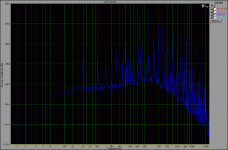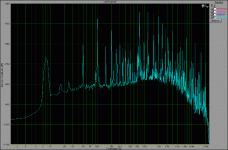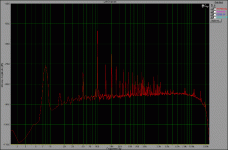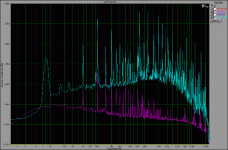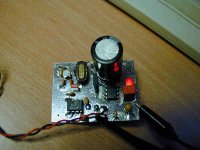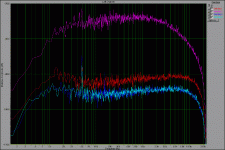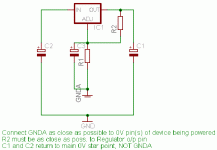For Ergo
It's been a little while, but I have built one of Elso's clocks and have it mounted in a CD63 KIS.
I had chosen to add a discrete, low noise regulator to the design, since PSU noise will contribute to the phase noise / jitter in the oscillator, and jitter in the buffer stage.
The same low noise reg was used to feed the inverter stage and the analogue PSU feeds of the DAC. This reg was fed from the raw 11.5 digital supply, that feeds the 5V internal regulator.
What I hadn't realised is just how horrendously noisy the internal supplies are. At idle there's a load of HF hash, along with some insidious LF stuff, at very high level, that occurs when play is pressed (presumably servo / motor currents).
The discrete reg., despite offering dramatically better performance and noise rejection than a 3-terminal device, was still allowing too much noise through.
The solution was to add an LM317 pre-reg. producing 8V to feed the discrete 5V reg. Using high divider resistor values, and a large adj. terminal bypass it was possible to attenuate the LF noise significantly, to the point where it's no longer visible at the discrete reg. o/p.
I have some plots of PSU noise I'll post later - it's truly horrendous, and it's one of the reasons for the performance of the player in standard form.
The player now sounds fantastic, bass is much tighter and characterful, rythm and timing is better portrayed. and treble is more detailed. There is a measurable effect on distortion of these mods, reducing by 0.003% according to my analyser. This may not be significant in itself, but shows that the effects on the digital parts affect the analogue domain.
Mid range is still not quite as good as I'd like, and I suspect the analogue internal 12V supplies are probably very noise too, and probably the reason.
I shall be doing a side-by-side audition tonight, but in my system I believe Elso's clock (with quiet PSU) is every bit the equal of the LC Audio XO. The lower noise PSU in this player (compared to my brother's with the LCLock and 317's) may be even better.
More later,
Andy.
It's been a little while, but I have built one of Elso's clocks and have it mounted in a CD63 KIS.
I had chosen to add a discrete, low noise regulator to the design, since PSU noise will contribute to the phase noise / jitter in the oscillator, and jitter in the buffer stage.
The same low noise reg was used to feed the inverter stage and the analogue PSU feeds of the DAC. This reg was fed from the raw 11.5 digital supply, that feeds the 5V internal regulator.
What I hadn't realised is just how horrendously noisy the internal supplies are. At idle there's a load of HF hash, along with some insidious LF stuff, at very high level, that occurs when play is pressed (presumably servo / motor currents).
The discrete reg., despite offering dramatically better performance and noise rejection than a 3-terminal device, was still allowing too much noise through.
The solution was to add an LM317 pre-reg. producing 8V to feed the discrete 5V reg. Using high divider resistor values, and a large adj. terminal bypass it was possible to attenuate the LF noise significantly, to the point where it's no longer visible at the discrete reg. o/p.
I have some plots of PSU noise I'll post later - it's truly horrendous, and it's one of the reasons for the performance of the player in standard form.
The player now sounds fantastic, bass is much tighter and characterful, rythm and timing is better portrayed. and treble is more detailed. There is a measurable effect on distortion of these mods, reducing by 0.003% according to my analyser. This may not be significant in itself, but shows that the effects on the digital parts affect the analogue domain.
Mid range is still not quite as good as I'd like, and I suspect the analogue internal 12V supplies are probably very noise too, and probably the reason.
I shall be doing a side-by-side audition tonight, but in my system I believe Elso's clock (with quiet PSU) is every bit the equal of the LC Audio XO. The lower noise PSU in this player (compared to my brother's with the LCLock and 317's) may be even better.
More later,
Andy.
I have the clock mods on hold at the moment but I also have some ideas I would like to try.
ALW, it is very interesting to read you findings though. The double regulator seems a very good solution.
I have tweaked one CD6000 and most likely I'm going to do another this week. I'll try to put together a conclusion of the changes in CD6000 and what tweaks I found that can be done there. Might even be I can make some pictures of the player pre/after tweak....
I haven't figured out the clock related parts in CD6000 jet. As there is a differential DAC in there they seem to have added an additional ic to chop up the data and send it to two DAC chips. One is doing right channel and the other left channel - both differentially. They have also put the clock generator on this additional ic and as I don't have the schematic, I dont know exactly how it is layed out.....
Ergo
PS. At the moment I'm still quite sure that the old CD67 and it's cousins are better : )
ALW, it is very interesting to read you findings though. The double regulator seems a very good solution.
I have tweaked one CD6000 and most likely I'm going to do another this week. I'll try to put together a conclusion of the changes in CD6000 and what tweaks I found that can be done there. Might even be I can make some pictures of the player pre/after tweak....
I haven't figured out the clock related parts in CD6000 jet. As there is a differential DAC in there they seem to have added an additional ic to chop up the data and send it to two DAC chips. One is doing right channel and the other left channel - both differentially. They have also put the clock generator on this additional ic and as I don't have the schematic, I dont know exactly how it is layed out.....
Ergo
PS. At the moment I'm still quite sure that the old CD67 and it's cousins are better : )
LM / TL431
Spartacus,
I've done a LOT of research on PSU's / regulators and noise recently (too much!).
One of the first devices I tried, in order to improve from my reference of an LM317 was the 431 shunt regualtors.
They are WAY noisier than a well implemented LM317, and have poor dynamic impedance characterstics.
Despite the recommendations of others, stay away from them -they're rubbish. I actually wonder where some people get these ideas from, it's obviously not based on actual measurements, or even sonic performance.
The noise specs in the data sheet for a 431 are usually at the min. o/p voltage, noise is amplified by loop gain - higher o/p V = higher noise.
An LT1086 is a MUCH better and quieter choice, with significantly better performance.
The Sulzer regs. are on hold at present, owing to the clock work, will resume soon (the clock had one fitted though).
Andy.
Spartacus,
I've done a LOT of research on PSU's / regulators and noise recently (too much!).
One of the first devices I tried, in order to improve from my reference of an LM317 was the 431 shunt regualtors.
They are WAY noisier than a well implemented LM317, and have poor dynamic impedance characterstics.
Despite the recommendations of others, stay away from them -they're rubbish. I actually wonder where some people get these ideas from, it's obviously not based on actual measurements, or even sonic performance.
The noise specs in the data sheet for a 431 are usually at the min. o/p voltage, noise is amplified by loop gain - higher o/p V = higher noise.
An LT1086 is a MUCH better and quieter choice, with significantly better performance.
The Sulzer regs. are on hold at present, owing to the clock work, will resume soon (the clock had one fitted though).
Andy.
The end result
This is the clock 5V supply, vs the internal 5V, the difference is clear.
Noise is nowhere near as low as I'd like, but I'm only using a TL071 as the error amp in the discrete regulator, a lower noise amp would make a big difference.
Still, there's almost 60dB of improvement in some areas
The important thing is the sonic difference is huge, without the pre-reg, bass is boomy, and bloated, and the music is disjointed. The cleaner clock supply makes bass tighter and allows the character of the instrument to show through (i.e. how and what is being, not just a LF noise), music gels and sounds like a band playing together, and low-level detail is dramatically improved.
This player would really benefit from a good clean external PSU, feeding the internal regulators, all of that noise could be removed completely with care, I suspect the +/- 12V supplies are equally noisy, and affect the sound detrimentally.
That's one for later though.
This is the clock 5V supply, vs the internal 5V, the difference is clear.
Noise is nowhere near as low as I'd like, but I'm only using a TL071 as the error amp in the discrete regulator, a lower noise amp would make a big difference.
Still, there's almost 60dB of improvement in some areas
The important thing is the sonic difference is huge, without the pre-reg, bass is boomy, and bloated, and the music is disjointed. The cleaner clock supply makes bass tighter and allows the character of the instrument to show through (i.e. how and what is being, not just a LF noise), music gels and sounds like a band playing together, and low-level detail is dramatically improved.
This player would really benefit from a good clean external PSU, feeding the internal regulators, all of that noise could be removed completely with care, I suspect the +/- 12V supplies are equally noisy, and affect the sound detrimentally.
That's one for later though.
Attachments
The conclusion
Popped round to see my brother tonight, and audition the CD63 KIS I've just modded with Elso's clock, to the original I did with an LCAudio LClock XO.
Interestingly the newly modified player needs significant warmup time (1 hr minimum) for it to sound it's best, something that doesn't occur with a standard CD63 or my brother's.
I suspect thermal effects in the clock as the reason. The LT1016 draws a fair bit of currrent, and the whole clock PCB probably takes an hour or so to reach thermal equilibrium. All the time temperature is changing there's likely to be phase noise variations correlated to the thermal effect. Some thermal reliefs around the ground plane of the oscillator may help, but I tend to leave my gear on 24/7 anyway.
There are other differences between the two players, that should be borne in mind. My brothers uses AD825 op-amps to replace the JRC2114's that form the post-DAC filter, the latest one uses LM6172's. The latest one has also had the filter caps changed to polystyrene.
The end result is good though, the Kwak-clocked player is every bit as musical as the LClocked version, and reveals insights into music the standard player only hints at. Rythmically there's a good boogie factor and foot-tapping element that few players manage.
The newer player seems to extend a little lower in the bass, which subjectively 'slows' the sound in direct comparison with the original, but the musical whole is cohesive and one realises that rythmically it's every bit as good. There's a lot of detail to bass lines, with the real character of the instrument and player coming through.
Detail retrieval is excellent, minor tonal differences between the players draw attention to different elements of the music at first listen, but there's nothing to choose between them over an extended listen.
The treble end is better on the new player, cymbals sound real, with detail such as where a stick is striking the cymbal being obvious, and it seems a little more extended and realistic.
I'm very pleased (the mods are for a friend) and would be more than happy to live with this player, when compared to my reference Naim CD5.
It loses out to the better player in ultimate rythmic portrayal, and midrange is better with voices being more emotive, by a fairly significant margin, on the Naim, but I suspect that's all down to PSU's and can be remedied.
I'll let you know, if ever I do it!
Andy.
Popped round to see my brother tonight, and audition the CD63 KIS I've just modded with Elso's clock, to the original I did with an LCAudio LClock XO.
Interestingly the newly modified player needs significant warmup time (1 hr minimum) for it to sound it's best, something that doesn't occur with a standard CD63 or my brother's.
I suspect thermal effects in the clock as the reason. The LT1016 draws a fair bit of currrent, and the whole clock PCB probably takes an hour or so to reach thermal equilibrium. All the time temperature is changing there's likely to be phase noise variations correlated to the thermal effect. Some thermal reliefs around the ground plane of the oscillator may help, but I tend to leave my gear on 24/7 anyway.
There are other differences between the two players, that should be borne in mind. My brothers uses AD825 op-amps to replace the JRC2114's that form the post-DAC filter, the latest one uses LM6172's. The latest one has also had the filter caps changed to polystyrene.
The end result is good though, the Kwak-clocked player is every bit as musical as the LClocked version, and reveals insights into music the standard player only hints at. Rythmically there's a good boogie factor and foot-tapping element that few players manage.
The newer player seems to extend a little lower in the bass, which subjectively 'slows' the sound in direct comparison with the original, but the musical whole is cohesive and one realises that rythmically it's every bit as good. There's a lot of detail to bass lines, with the real character of the instrument and player coming through.
Detail retrieval is excellent, minor tonal differences between the players draw attention to different elements of the music at first listen, but there's nothing to choose between them over an extended listen.
The treble end is better on the new player, cymbals sound real, with detail such as where a stick is striking the cymbal being obvious, and it seems a little more extended and realistic.
I'm very pleased (the mods are for a friend) and would be more than happy to live with this player, when compared to my reference Naim CD5.
It loses out to the better player in ultimate rythmic portrayal, and midrange is better with voices being more emotive, by a fairly significant margin, on the Naim, but I suspect that's all down to PSU's and can be remedied.
I'll let you know, if ever I do it!
Andy.
hi folks !
ive been tweaking with my player several months ago obtaining
serious great results.
everybody should try these items !
Q do your player have transistorizied mute for audio???
A if yes, rip it off & replce with a relay.
Q do your player have a push-pull transistor servo circuit ???
(focus/track/traverse/spindle)
A if yes . install a small regulated +/-- power supply for those
transistors only.
Q do you have an original clock ???
A if yes make a dual regulated power supply & install an elso kwak clock.
replace op amps & capacitors at your own taste !
you will hear an 100 bucks player sounding a lot better than those expensive ones.
try reclocking the bit clock for an almost warmth analog sound.
with an 74hcoo & 2 resistors.
need more info let me know
richt
ive been tweaking with my player several months ago obtaining
serious great results.
everybody should try these items !
Q do your player have transistorizied mute for audio???
A if yes, rip it off & replce with a relay.
Q do your player have a push-pull transistor servo circuit ???
(focus/track/traverse/spindle)
A if yes . install a small regulated +/-- power supply for those
transistors only.
Q do you have an original clock ???
A if yes make a dual regulated power supply & install an elso kwak clock.
replace op amps & capacitors at your own taste !
you will hear an 100 bucks player sounding a lot better than those expensive ones.
try reclocking the bit clock for an almost warmth analog sound.
with an 74hcoo & 2 resistors.
need more info let me know
richt
Shunt reg's
Hi Dave,
It's just a reasonable sound card (SBLive), fronted by a v.low noise buffer amp and SpectraLAB FFT analyser software, that's why measurements are limited to the audio band. A modern 96k sound card will get you outside of that limitation.
I'm of the opinion (and it's just that, my opinion) that there is no real benefit to shunt reg's per se. If one is really concerned about sinking and sourcing current this can be easily achieved by pre-loading a linear regulator with a resistive load, equal to the current one wishes to sink.
The topology of most shunt reg's makes it difficult to filter the low dynamic impedance of the reference - an absolute necessity for low noise performance.
In terms of efficiency and dropout a good linear reg. will give better results, it's easy to achieve noise performance equal to the error amp alone, with a little care. This means with something like an AD797 noise levels can be as low as 0.9nV / root Hz!
Line rejection can reach >110dB, along with output impedances in the microOhms range, in effect < than the impedance of the wiring one would use post-reg!.
Try it though, and let us see the results, I'm always open to ideas!
Andy.
Hi Dave,
What gear are you using to get those measurements?
It's just a reasonable sound card (SBLive), fronted by a v.low noise buffer amp and SpectraLAB FFT analyser software, that's why measurements are limited to the audio band. A modern 96k sound card will get you outside of that limitation.
Also what do you think of constant current sourced shunt regulators? I'm thinking of drawing one up have you had any experience with these?
I'm of the opinion (and it's just that, my opinion) that there is no real benefit to shunt reg's per se. If one is really concerned about sinking and sourcing current this can be easily achieved by pre-loading a linear regulator with a resistive load, equal to the current one wishes to sink.
The topology of most shunt reg's makes it difficult to filter the low dynamic impedance of the reference - an absolute necessity for low noise performance.
In terms of efficiency and dropout a good linear reg. will give better results, it's easy to achieve noise performance equal to the error amp alone, with a little care. This means with something like an AD797 noise levels can be as low as 0.9nV / root Hz!
Line rejection can reach >110dB, along with output impedances in the microOhms range, in effect < than the impedance of the wiring one would use post-reg!.
Try it though, and let us see the results, I'm always open to ideas!
Andy.
Andy, thanks for sharing the results of your research.
As far as I can see, the benefit of a shunt reg is that at high frequencies after the reg has given up, there will still be an RC filter at work (depending on the impedance of the cap after the reg). So maybe devices like the TL431 would be useful for digital circuits with pre-regulation form a 317.
I've built a few clocks in the past, and have had good results from a now obselete Motorola chip, the MC12061. I tried a 7805 first, then an LT323, then added sanyo Os-Cons, then fed the thing from a battery, and to be honest I couldn't tell any difference from the basic PSU I used originally. Maybe an op-amp based reg will help.
A thought on op-amp based regs in general - would it be feasable to lose the pass transistor by using a high Iout op-amp, such as LM6171? It would certainly simplify design (important if trying to make somthing to replace 3 terminal regs).
As far as I can see, the benefit of a shunt reg is that at high frequencies after the reg has given up, there will still be an RC filter at work (depending on the impedance of the cap after the reg). So maybe devices like the TL431 would be useful for digital circuits with pre-regulation form a 317.
I've built a few clocks in the past, and have had good results from a now obselete Motorola chip, the MC12061. I tried a 7805 first, then an LT323, then added sanyo Os-Cons, then fed the thing from a battery, and to be honest I couldn't tell any difference from the basic PSU I used originally. Maybe an op-amp based reg will help.
A thought on op-amp based regs in general - would it be feasable to lose the pass transistor by using a high Iout op-amp, such as LM6171? It would certainly simplify design (important if trying to make somthing to replace 3 terminal regs).
TL431 with pre regulation??
I'm just starting to design a DAC, but I'm kind of stuck on the power supply at the moment...
Would you say the TL431s with a pre regulated supply would be good for the analogue supplies?
I realise that the power supplies are important, but I don't have enough time to go over board, so I want to keep things as simple as possible, so what do you think is the best implementation with an LT317 / 337??
-Mark.
I'm just starting to design a DAC, but I'm kind of stuck on the power supply at the moment...
Would you say the TL431s with a pre regulated supply would be good for the analogue supplies?
I realise that the power supplies are important, but I don't have enough time to go over board, so I want to keep things as simple as possible, so what do you think is the best implementation with an LT317 / 337??
-Mark.
Mark,
Personally I wouldn't use TL431's for anything.
In many low current app's I'd get better performance from an RC .
.
Anyway, here's the optimal connection scheme for an LM317 / 337 / LT1086 etc.
Wire like this and you won't go far wrong, it's important too - measure the reg anywhere other than between GNDA and o/p an it will look much noisier than it should. The three terminal reg's work by maintaing their o/p relative to the Kelvin sense point - just 1mm away along a track with current flowing in it will make it look noisier - believe me, I've battled for ages before the eureka moment!
Andy.
Personally I wouldn't use TL431's for anything.
In many low current app's I'd get better performance from an RC
Anyway, here's the optimal connection scheme for an LM317 / 337 / LT1086 etc.
Wire like this and you won't go far wrong, it's important too - measure the reg anywhere other than between GNDA and o/p an it will look much noisier than it should. The three terminal reg's work by maintaing their o/p relative to the Kelvin sense point - just 1mm away along a track with current flowing in it will make it look noisier - believe me, I've battled for ages before the eureka moment!
Andy.
Attachments
Mark,
I think on a new DAC (too). I try AD1853 current out, maybe with step up out.transformers and built in a CD player, with extra master clock and evtl. a external version with CS8420 upsampler to 70kHz; tests on pow.supp. reg. like TL431 iam doing, because improving isolation to other stages, compared with std regs like 7805 / 317; noise is a problem...
Alf
I think on a new DAC (too). I try AD1853 current out, maybe with step up out.transformers and built in a CD player, with extra master clock and evtl. a external version with CS8420 upsampler to 70kHz; tests on pow.supp. reg. like TL431 iam doing, because improving isolation to other stages, compared with std regs like 7805 / 317; noise is a problem...
Alf
Noise problems
There are big benefits to isolating different circuits etc. but I strongly reccomend using LM317 / 337, cost is little different to TL431, but performance is much, much better. Noise and output impedance are much lower in an adjustable 3-terminal.
See previous plot for comparison of TL431 noise vs 3-terminal reg's.
Andy.
tests on pow.supp. reg. like TL431 iam doing, because improving isolation to other stages, compared with std regs like 7805 / 317; noise is a problem...
There are big benefits to isolating different circuits etc. but I strongly reccomend using LM317 / 337, cost is little different to TL431, but performance is much, much better. Noise and output impedance are much lower in an adjustable 3-terminal.
See previous plot for comparison of TL431 noise vs 3-terminal reg's.
Andy.
- Status
- This old topic is closed. If you want to reopen this topic, contact a moderator using the "Report Post" button.
- Home
- Source & Line
- Digital Source
- Marantz CD67 clock mod.. my experiences
